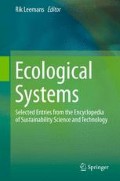Abstract
Ecosystem services provide the basis for all human activity. Maintaining their sustained function is of critical concern as the issues of sustainability addressed here in this encyclopedia are approached. At root, the ecosystem is a thermodynamic system receiving, collecting, transforming, and dissipating solar energy. The energy pathways are varied and complex and lead to the diversity of form and services available on the earth. Therefore, it is necessary to understand the ecosystem as a thermodynamic system and how the energy flows enter, interconnect, and disperse from the environmental system. Ecological network methodologies exist to investigate and analyze these flows. In particular, partitioning the flow into boundary input, noncycled internal flow, and cycled internal flow shows the extent to which reuse and recycling arise in ecosystems. The intricate, complex network structures are responsible for these processes all within the given thermodynamic constraints. Design of sustainable human systems could be informed by these organizational patterns, in order to use effectively the energy available. This article demonstrates the need for flow analysis, provides a brief example using a well-studied ecosystem, and discusses some of the ecosystem development tendencies which can be addressed using ecosystem flow analysis.
This chapter was originally published as part of the Encyclopedia of Sustainability Science and Technology edited by Robert A. Meyers. DOI:10.1007/978-1-4419-0851-3
Access this chapter
Tax calculation will be finalised at checkout
Purchases are for personal use only
Abbreviations
- Consumer:
-
Heterotrophic organism that consumes other organisms for their energy requirements.
- Cycling:
-
The process by which energy or matter returns from its compartment of origin before exiting the system boundary.
- Ecological goal function:
-
Tendency observed in the orientation or directional development of ecological systems.
- Flow:
-
The transfer of energy or matter from one compartment in the system to another by active (feeding) or passive (death, egestion) means.
- Network analysis:
-
A mathematical tool to study objects as part of a connected system and to identify and quantify the direct and indirect effects in that system.
- Primary producer:
-
Photosynthesizing organism that captures external energy sources and brings it into the system as the basis for all subsequent thermodynamic activity.
- Thermodynamic system:
-
A bounded system defined by the quantities of energy and matter flowing through it.
Bibliography
Primary Literature
Daly HE, Townsend KN (1993) Valuing the earth: economics, ecology, ethics. MIT Press, Cambridge, MA, p 399
Diamond J (2005) Collapse: how societies choose to fail or succeed. Penguin Press, New York, p 575
Fath BD, Jørgensen SE, Patten BC, Straškraba M (2004) Ecosystem growth and development. Biosystems 77:213–228
Hannon B (1973) The structure of ecosystems. J Theor Biol 41:535–546
Levine SH (1977) Exploitation interactions and structure of ecosystems. J Theor Biol 69:345–355
Fath BD, Scharler U, Ulanowicz RE, Hannon B (2007) Ecological network analysis: network construction. Ecol Model 208:49–55
Finn JT (1976) Measures of ecosystem structure and function derived from analysis of flows. J Theor Biol 56:363–380
Higashi M, Patten BC, Burns TP (1993) Network trophic dynamics: the modes of energy utilization in ecosystems. Ecol Model 66:1–42
Fath BD, Patten BC, Choi JS (2001) Complementarity of ecological goal functions. J Theor Biol 208:493–506
Tilly LJ (1968) The structure and dynamics of Cone Spring. Ecol Monogr 38:169–197
Braner M (1985) A simple random path method for the analysis of flow networks. Ecol Model 28:165–180
Odum EP (1969) The strategy of ecosystem development. Science 164:262–270
Lotka AJ (1922) Contribution to the energetics of evolution. Proc Natl Acad Sci USA 8:147–151
Schneider ED, Kay JJ (1994) Life as a manifestation of the second law of thermodynamics. Math Comput Model 19:25–48
Morowitz HJ (1968) Energy flow in biology; biological organization as a problem in thermal physics. Academic, New York
Cheslak EF, Lamarra VA (1981) The residence time of energy as a measure of ecological organization. In: Mitsch WJ, Bossermann RW, Klopatek JM (eds) Energy and ecological modelling. Elsevier, Amsterdam, pp 591–600
Onsager L (1931) Reciprocal relations in irreversible processes. Phys Rev 37:405–426
Prigogine I, Wiame JM (1946) Biologie et Thermodynamique des Phenomenes Irreversible. Experientia II:451–453
Odum HT (1988) Self-organization, transformity, and information. Science 242:1132–1139
Ulanowicz RE (1997) Ecology, the ascendent perspective. Columbia University Press, New York
Lindeman RL (1942) The trophic dynamic aspect of ecology. Ecology 23:399–418
Pomeroy LR (1974) The ocean’s food web, a changing paradigm. Bioscience 24:499–504
Finn JT (1976) Measures of ecosystem structure and function derived from analysis of flows. J Theor Biol 56:363–380
Patten BC (1978) Systems approach to the concept of environment. Ohio J Sci 78:206–222
Patten BC (1985) Energy cycling in the ecosystem. Ecol Model 28:1–71
Books and Reviews
Burns TP (1989) Lindeman’s contradiction and the trophic structure of ecosystems. Ecology 70:1355–1362
Finn JT (1980) Flow analysis of models of the Hubbard Brook ecosystem. Ecology 61:562–571
Latham LG (2006) Network flow analysis algorithms. Ecol Model 192:586–600
Ulanowicz RE (1983) Identifying the structure of cycling in ecosystems. Math Biosci 65:219–237
Whipple SJ (1999) Analysis of ecosystem structure and function: extended path and flow analysis of a steady-state oyster reef model. Ecol Model 114:251–274
Author information
Authors and Affiliations
Corresponding author
Editor information
Editors and Affiliations
Rights and permissions
Copyright information
© 2013 Springer Science+Business Media New York
About this chapter
Cite this chapter
Fath, B.D. (2013). Ecosystem Flow Analysis. In: Leemans, R. (eds) Ecological Systems. Springer, New York, NY. https://doi.org/10.1007/978-1-4614-5755-8_5
Download citation
DOI: https://doi.org/10.1007/978-1-4614-5755-8_5
Published:
Publisher Name: Springer, New York, NY
Print ISBN: 978-1-4614-5754-1
Online ISBN: 978-1-4614-5755-8
eBook Packages: Biomedical and Life SciencesBiomedical and Life Sciences (R0)

